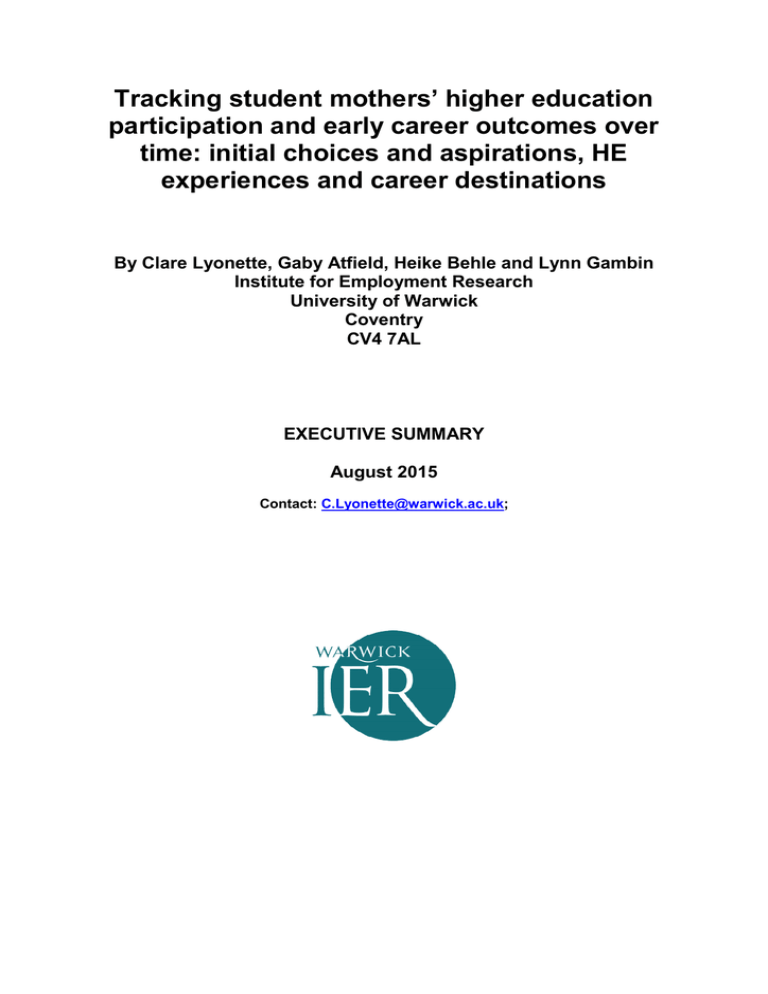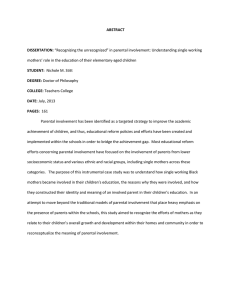Tracking student mothers’ higher education participation and early career outcomes over
advertisement

Tracking student mothers’ higher education participation and early career outcomes over time: initial choices and aspirations, HE experiences and career destinations By Clare Lyonette, Gaby Atfield, Heike Behle and Lynn Gambin Institute for Employment Research University of Warwick Coventry CV4 7AL EXECUTIVE SUMMARY August 2015 Contact: C.Lyonette@warwick.ac.uk; EXECUTIVE SUMMARY Introduction: There has been an emphasis in recent years on widening participation in Higher Education (HE). Although there have been some positive changes overall, there is still a much higher proportion of students from higher than from lower social class backgrounds attending Higher Education Institutions (HEIs) and there are also vast differences by social class in the proportion of students attending the highest tariff HEIs and in the subjects studied. There are also large gender differences in the subjects chosen at HE, with important implications for the labour market outcomes of men and women later in life. There have been relatively few studies of student mothers who may face particular challenges in achieving successful outcomes within and after HE. The following report aims to address this gap. Funded by the Nuffield Foundation, this research sets out to examine the experiences of a large and diverse group of student mothers aged over 21 during and after HE, to see whether or not inequalities break down as a result of HE and whether or not student mothers can achieve social mobility, in comparison with other students of similar ages without children. A mixed-methods approach is employed, including statistical analysis of Futuretrack, a national, longitudinal, online survey of all full-time 2005-6 UCAS applicants, as well as new semi-structured interviews with a selected sample of student mothers. The research is particularly timely, given the recent increases in HE tuition fees, raising concerns about future HE participation among mature students. Already, the numbers of mature students and part-time students have decreased since the introduction of higher tuition fees (HESA data, 2014). The study was broken down into three distinct pieces of work: A comprehensive literature review; Quantitative, longitudinal analysis of Futuretrack data; Follow-up qualitative interviews with a sample of student mothers. The literature review: The main findings from the literature review demonstrated that: The demands of juggling childcare and domestic work with studying, and in many cases with paid work, are particularly difficult for student mothers. The division of domestic work and childcare appears unchanged for women who continue to take on the majority of such responsibilities, even with the addition of a student role. Partners and other relatives vary in their responses to women taking on the student role, and support from significant others appears patchy, although important. Most student mothers are limited in their choice of HEI, choosing to study locally in order to manage childcare, children’s education and partners’ work. Universities vary in their response and level of support, with many students having to rely upon individual staff members, and others missing classes or turning up late, due to child sickness or difficulties with course timetabling, which often change at short notice. Those universities with the greater resources appear to have better facilities and structural supports (e.g., on-site crèches) but student mothers are less likely to attend such HEIs. How HEIs respond to the needs of student mothers can have the (potentially adverse) effect of maintaining and highlighting the ‘otherness’ of students with childcare responsibilities. However, until student parents are recognised as having unique needs and requiring specific support, they may remain invisible and isolated, with a greater risk of dropping out. Single student mothers are most at risk of negative outcomes, both in terms of the level of demands placed upon them, but also in terms of financial hardship. Many rely heavily upon grandparents and friends for childcare support. Most of the student mothers in the various articles and reports outlined study to improve their career prospects, but many increase their self-confidence and esteem as a consequence of HE. Many also report on the importance of acting as good role models for their children. The experiences of student mothers tend to vary by many different interlinking factors, including social class, ethnicity and marital status. The quantitative and qualitative data findings: The initial aims of the project were to examine ‘whether or not inequalities break down as a result of HE and whether or not student mothers can achieve social mobility, in comparison with other students of similar ages without children’. Our findings suggest that inequalities do not appear to break down as a result of HE. Some student mothers can and do achieve social mobility, in that they progress into a better job than before. However, the restricted choices of HEIs and of courses specifically chosen by student mothers, the lack of information about the reality of such jobs upon graduation, the difficulties and barriers encountered on their HE journey, and the similarly restricted occupational choices made after HE, suggest that this group of students experience relatively poor social mobility, in comparison with other female students. Younger female non-mothers are more likely than mature students (both mothers and nonmothers) to be in non-graduate jobs and earning lower salaries overall soon after qualifying from HE. It must be remembered, however, that younger students have a greater degree of flexibility in that they are more able to take some time out after studying to reflect on their options, go travelling, take on internships and other (unpaid) work, leading towards the job they eventually want. The additional follow-up interviews carried out for this project in 2014 (up to 8 years after their initial application to HE), showed that the majority of student mothers had not moved into the jobs they initially anticipated when applying to HE and were unlikely to do so. Many had dropped out of HE. Our research further highlights the various differences between mothers and non-mothers from the point of applying to HE and eventually moving into the labour market. Specifically: Student mothers are very different from all other female students entering HE, even those of a similar age. Motherhood has a significant impact on women’s choices and experiences before entering HE, during HE and afterwards. Similar-aged women without children are also different from “traditional” students who enter HE at 18 or 19 but seem to occupy a middle ground between mothers and younger non-mothers. A higher proportion of student mothers are from lower socioeconomic backgrounds and are more likely to study locally than all other female students, primarily because of childcare arrangements, children’s schools and partners’ work. They are also more likely to choose lower tariff HEIs and to choose particular subjects, e.g., Social Studies, Subjects allied to Medicine and Education, and aspire to female-dominated jobs in the public sector: nursing, social work, teaching and midwifery, which would not have required a degree in the past. The reality of such jobs is often very different from what was initially expected. There appears to be a lack of early information for student mothers about what these, and other popular job choices, entail. Placements often represent a crunch point, either during the degree itself or during a post-graduate year (e.g., PGCE). Of those mothers who drop out of HE, many do so because of the various barriers and difficulties of managing childcare and studying (often combined with work). Most mothers do not visit the careers service or the student union during their time in HE (primarily due to a lack of time and a perceived lack of relevance). For many student mothers, Higher Education is an opportunity that was not available to them when they were younger, and many are very positive about the overall HE experience. For example, they are more likely than other female students to think that their course helped them in self-confidence and spoken communication. Family support and social networks are crucial during the HE experience. Partners often facilitate the inflexibility of HE timetabling by having greater flexibility in their work in order to provide support with childcare. Single mothers appear to be a particularly disadvantaged group, supporting previous research on student mothers in the UK and elsewhere. Many mothers compromise when entering the labour market by putting their careers on hold or going back to their old jobs (more mothers than other graduates were already working for their current employer). Many are exhausted from the overall HE experience and feel that they need to take some time out or devote some more time to their children and partners. A similar proportion of mothers and other mature student women are employed in non-graduate jobs, but mothers are more likely to choose a job because it is local and because it is compatible with a partner’s career. These limited choices mirror their initial decisions regarding HE and also represent a level of ‘pay-back’ for partners’ support during HE. On the other hand, when age, subject, class of degree and type of HEI were included in a regression analysis, the impact of motherhood on the likelihood of being in graduate employment became insignificant, whilst the impact of SES remained constant. Motherhood as such does not appear to have any immediate impact on the likelihood of graduate employment whilst age, subject group, class of degree and type of HEI does. Older women are more likely than younger women to enter graduate employment; those doing Subjects allied to Medicine and Education do better compared with those doing Physical Sciences; those attending the highest tariff HEIs do better than those attending lower tariff ones; and those getting a better class of degree are more successful in gaining graduate employment than those not doing so. It appears that those mothers surviving the HE experience do well in gaining graduate employment, although the types of graduate jobs undertaken by female graduates do vary by motherhood status. Mothers are more likely than other female graduates to be working part-time, doing voluntary work or are not in employment (and not looking for work). Those working part-time tend to be in lower-level jobs than originally intended, e.g., support workers rather than social workers, or teaching assistants rather than teachers. These lowerlevel jobs could be done without a degree. Even if they go back to the job they had before, or are working in a lower-level support role, student mothers often have a greater appreciation of that job and, in many cases, aspirations for the future or for other things they might do. While some mothers had negative experiences of HE, many valued the whole experience and their success in having completed a degree, which goes beyond simple employment outcomes. Many talked about acting as good role models and being able to discuss HE with their children as they started to consider HE options. Other positive outcomes for mothers included self-fulfilment, greater self-confidence, gaining a broader outlook on the world, and a general appreciation of the skills they have gained. Preliminary recommendations: • HEIs should engage more with student mothers at the earliest opportunity during the application process to provide tailored advice about the courses available. Advice and support should be focused on widening participation in different degree courses, not focusing solely on very vocational courses at lower-ranked universities. • HEIs should ask applicants specific questions upon registering for HE which would help to identify and target those most in need of help (student mothers are only one group among many which can gain from such support, but they are less likely to look for it than other groups of students). • Careers advice needs to be more relevant to student mothers and could be offered in a different way than the offer for “traditional” students with more time available (e.g., greater online support). • HEIs need to consider the impact of timetabling on student mothers. In courses where there are lots of similar-aged women it would make sense to timetable according to their needs. Timetables need to be rigorously maintained and adhered to, and if changes are made, student mothers should be given special consideration. • Many student mothers are reluctant to ask for special consideration but then find it particularly difficult when emergencies occur. Lecturers and course directors should provide greater flexibility for student mothers and those in greater need of support. • More courses need to be offered on a part-time basis, especially those which attract a high number of mothers. This more flexible provision will help to reduce the number of drop-outs from HE. • Simple categorisations and measures of “success” from HE (i.e., a graduate job) need to be extended and re-evaluated as this could reduce HEIs’ willingness to accept students with more varied backgrounds. The ‘value added’ provided by an HE is a better indicator of success, especially for non-traditional students who start from a particularly low base and struggle with additional responsibilities while studying. Acknowledgements The Nuffield Foundation is an endowed charitable trust that aims to improve social wellbeing in the widest sense. It funds research and innovation in education and social policy and also works to build capacity in education, science and social science research. The Nuffield Foundation has funded this project, but the views expressed are those of the authors and not necessarily those of the Foundation. More information is available at www.nuffieldfoundation.org





